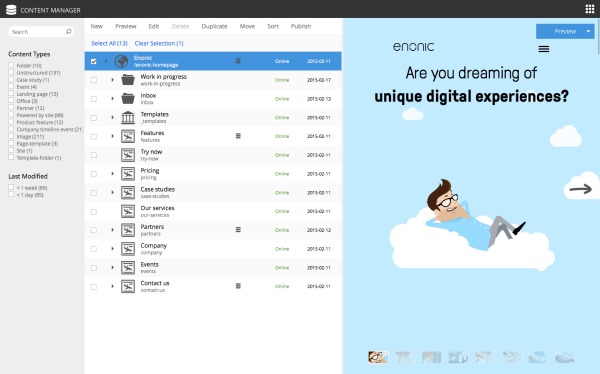Enonic wanted to change. And change quickly.
Kinda like its customers — those charged with delivering digital brand messages every day.
“Our idea was to build portal technology,†said Thomas Sigdestad, co-founder and CTO for the Oslo, Norway-based provider that launched in 2000. “But around 2010 we concluded that we had to make some big changes and we went to open source. We started creating our new platform. We basically threw all the cards into the air and started from scratch.â€
About 100,000 labor hours later, the transformation led to the April release of the Enonic eXperience platform (XP) and Enonic Cloud. Sigdestad and Co. promise the platform delivers “WordPress convenience†with “enterprise functionality.â€
This will make them, they claim, the “No. 1 open source vendor in the digital experience platform space by 2020.â€
“We’re ambitious,†Sigdestad said.
Who’s the Target?

“With Enonic XP we want to target those who create unique cloud-based applications — or advanced websites,” Sigdestad said. “We aim to make the platform extremely attractive for internet startups, but we believe this focus will also make it highly valuable to forward-thinking enterprises with similar ambitions and requirements.”
Enterprises, Sigdestad promised, can use the provider’s combined offering of software and cloud and “take full control over mission-critical and highly-integrated solutions with our software.” “And at the same time,” he said, enterprises can run “low risk†or temporary efforts in the Enonic Cloud, using the same technology all the way.
Enonic is growing globally. Most of its customers are based in Norway, but the team recently opened an office in San Francisco, a development department in Minsk, Belarus, and is working with a distributor in Bogotá, Colombia.
Expansion is not the only way Enonic wants to globally expand.
Last month, the open source CMS vendor announced a partnership with Jahia on a concept called Context Server (CXS). The Context Server enables creation of consistent personalized user experiences across markets, channels and systems. It provides real-time actionable insights on user behavior.
Digital Lifecycle
In a Skype interview with CMSWire, Sigdestad said organizations must redefine how they create, deliver and manage digital experiences.

“We discovered when we looked at all aspects involved in creating applications, services and content there is one major issue for all companies that are innovating. And it’s basically complexity,” he said. “We see that complexity as a killer when it comes to driving and delivering a new solution, applications and digital experiences.â€
Sigdestad said that Enonic came up with a “prescription†for the “501†“not implemented†error-message illness that plagues many organizations.
Some ingredients for that include:
- Open source (commercial support available). Platforms that need change need open source technology supporting it. “That’s not debatable in our opinion,†Sigdestad said. “It gives you flexibility in all terms. It’s accessibility for any developer to grab hold of things and make use of it. And you’re building a community around it.â€
- Search (Elasticsearch). Enonic officials built storage on top of its search engine to avoid the need to index. Elasticsearch is at the core, Sigdestad said, “and everything that gets put into storage automatically indexes. It’s a really cool search. There’s no such thing as a third-party database.â€
- Storage (NoSQL storage built on top of Elasticsearch). “Rather than use something that was a compromise,†Sigdestad said, “we made our own storage technology. We have the ability to have repositories and branches. We bring together capabilities from Filesystem, Git, NoSQL, document stores and search in our unique storage technology.”
- Application server (Java Open Services Gateway Initiative (OSGi)-based module system).Everyone depends on an application server to deploy code. “We decided to get rid of the dependency for the application server,†he said. “We are actually an application server by default — you can insert your own modules and code directly into the system and remove it while everything is running.â€
- Delivery tier (Serverside JavaScript/Node.js + rails concept). Enonic supports require.js in its serverside JavaScript MVC framework. “JavaScript is the one thing that unifies everything,†Sigdestad said, “so we created a delivery method where you can code everything on the front end with Serverside JavaScript. It means every developer out there that does HTML CSS JavaScript can also do Serverside.†Enonic’s platform also includes “natural templating,†which allows users to create a plain HTML5 document and use that as the view. “You could have your designer work on the HTML file while a more hardcore developer makes it more dynamic,†Sigdestad said.
- Responsive HTML5 user interface (UI) framework (back-office applications)
- Experience Manager (integrates content and applications). “The thing that’s missing when making stacks is making things like applications dynamic,†Sigdestad said. “And we created a Web CMS that is fully integrated and works seamlessly on top of all this.”
“Basically, we think we have the right cocktail,†he said. “You can’t do this overnight. It’s not like you can just launch a startup now and complete this. We’ve spent 10 years learning and four years implementing it all over again.â€
Officials said the platform’s capabilities will be visible when the marketplace for EnonicXP is launched — facilitating, sharing, sales and distribution of a wide set of modules and applications. It will feature blogs, social intranets, Google Analytics integrations, LDAPConnectors, commerce sites and social integrations.
-
Top Articles
-
Related Articles
-
Recent Comments
- Is Salesforce For Sale?
 view comments
view comments
Did you hear the one about Salesforce.com selling itself to a competitor? It’s not a joke, at least according to news reports that sent shock waves through the technology world… - Office 365 is a Disaster Waiting to Happen
 view comments
view comments
I’m hesitant to add another blog to the pile about Office 365, because there are more than enough talking heads out there prognosticating.But I spent the last week at the… - 8 Ways to Kill Your Intranet
 view comments
view comments
A good intranet comes with … well, it’s been a source of debate lately. It’s a debate hot enough to draw its own conference. Of all the talk, it’s about one tenet… - 3 Features Office 365 Needs to Launch in 2016
 view comments
view comments
Once upon a time we all worked in cubicles, separated from colleagues and very much siloed. These days many of us are lucky enough to work in more funky, open… - Is Microsoft Still Relevant?
 view comments
view comments
If Microsoft has the tenacity to hold the technology press in suspense for more than a week, with back-to-back conferences (Build this week in San Francisco, Ignite next week… - How Evergage Makes Google Analytics Better
 view comments
view comments
Most business owners now understand analytics is an essential tool that can highlight efficiency and opportunities for innovation. This shift in thinking has lead to opportunities for innovating analytics measurement… - Todd Klindt: Ripples of Sadness Over SharePoint
 view comments
view comments
I can’t always be trusted to take things as seriously as I probably should. It just depends on what’s going through my head at the time, and how much coffee…
Useful article?
 Email It
 Â
 Â
Article source: http://www.cmswire.com/cms/web-cms/enonic-boasts-wordpress-ease-enterprise-functionality-029038.php
